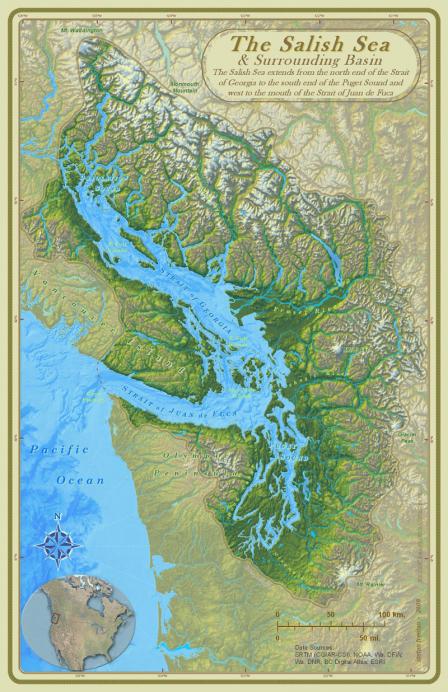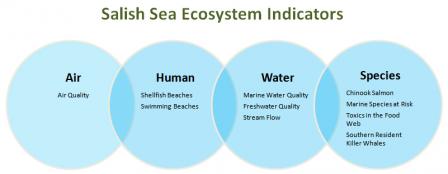Executive Summary: Health of the Salish Sea Report
 What is the Salish Sea? The Salish Sea is a marine ecosystem that extends from the north end of the Strait of Georgia in British Columbia, Canada, to the south end of Puget Sound in Washington in the U.S., and west to the mouth of the Strait of Juan de Fuca where it meets the Pacific Ocean. Map courtesy of Western Washington University.
What is the Salish Sea? The Salish Sea is a marine ecosystem that extends from the north end of the Strait of Georgia in British Columbia, Canada, to the south end of Puget Sound in Washington in the U.S., and west to the mouth of the Strait of Juan de Fuca where it meets the Pacific Ocean. Map courtesy of Western Washington University.Overview
The Health of the Salish Sea Report is a joint initiative between EPA and Environment and Climate Change Canada. It describes trends that help us identify priorities for action across the entire Salish Sea.
Coast Salish people have lived in balance within the Salish Sea ecosystem since time immemorial. Currently, over seven million people live in the areas around the Salish Sea, benefiting from the resources the ecosystem provides.
By the year 2025, we can expect the population in the Salish Sea ecosystem to expand to over nine million people. Sustainability of the Salish Sea ecosystem is critical to our continued use and enjoyment of this place.
In 2000, EPA and Environment Canada signed a Joint Statement of Cooperation to facilitate cross-border understanding, dialogue, and collaboration on Salish Sea issues. Under this partnership, we selected a set of "ecosystem indicators" to help show where we are seeing progress in sustainably managing the Salish Sea ecosystem and its valuable resources, where conditions are declining, and where course corrections are needed.
The ten indicators address the following questions:
- What's happening?
- Why is it important?
- Why is it happening?
- What are we doing about it?
For each indicator, we also present Coast Salish traditional ecological knowledge as "sustainable perspectives." Coast Salish knowledge allows us to extend the timeline for indicators and draw attention to the significance of connections among indicators.
Ecosystem Trends
 We're studying the trends for ten interconnected environmental indicators that help give us a better picture of the current environmental, economic, and social well-being of our Salish Sea watershed.
We're studying the trends for ten interconnected environmental indicators that help give us a better picture of the current environmental, economic, and social well-being of our Salish Sea watershed.
We see positive trends on some issues, such as improving air quality and reductions in certain persistent toxic chemicals in the aquatic food web. Other issues, such as habitat protection and water quality, need more attention.
Below are summaries of the ten indicators we're studying. To learn more about the status of each indicator, follow the links provided to our full reports.
Air Indicators
Air Quality (Fine Particulates) - Improving
13 of the 14 air monitoring stations in our study meet both Canadian and U.S. standards, and air quality is generally improving thanks to new actions in Washington and British Columbia that control sources of air pollution.
Species Indicators
Marine Species at Risk - Declining
Between 2008 and 2011, 23 new species were identified as threatened or of concern, representing the greatest increase since reporting was established in 2002.
Chinook Salmon - Declining
Chinook salmon populations are down 60% since the Pacific Salmon Commission began tracking salmon data in 1984.
Southern Resident Killer Whales - Declining
Despite recent births in the second half of 2015 and beginning 2016, there has been a net loss of Southern Resident Killer Whales since 2011. This trend along with the continued decline of Chinook salmon, and the noted appearance of emaciation among members of the local pods, are reasons we are downgrading the previous status of Southern Resident Killer Whales from a neutral trend to a declining trend.
Toxics in the Food Web: Pacific Herring and Harbor Seals - Improving
Levels of PCBs in harbor seals have been declining since the 1980s, though the decline has slowed in recent years. Levels of flame retardant chemicals - called PBDEs - are also declining in harbor seals.
Water Indicators
Freshwater Quality - Improving
Of the seventeen rivers we assessed, none showed statistically significant declining trends over the ten year period from 2000 to 2010. Though twelve of the rivers either regularly or occasionally exceeded water quality guidelines, improving trends were observed in three of the rivers (Samish, Nisqually, and Deschutes).
Marine Water Quality - Declining
Marine dissolved oxygen is showing a long term decline in the waters of Puget Sound and in the deeper waters of Georgia Strait. Marine Water Condition Index scores also have been in general decline over the past ten years for many areas in Puget Sound.
Stream Flow - Declining
10 of the 17 rivers we studied showed decreasing summer flow trends since 1975. Five of the remaining seven rivers showed only minor increases or decreases in flow. Streamflow is vital to how humans and aquatic organisms use Salish Sea waterways. Humans put demands on waterways that can severely degrade and disrupt natural processes, such as salmon migrations.
Human Well-Being Indicators
Shellfish Harvesting - Neutral
Between 2007 and 2016, over 3,800 acres of previously closed shellfish beds in Puget Sound have been upgraded or re-opened due to improvements in water quality. However, there has also been an overall increase in the number of acres of shellfish beds that are prohibited or restricted from harvesting. This increasing trend is due partly to increased water quality monitoring, changes in classifying closed areas and methods of mapping beach closures.
Swimming Beaches - Neutral
Overall, nearly three-quarters of swimming beaches in the Salish Sea consistently meet standards. This indicator is also closely linked to local actions.
Inspire Action
We all have a common interest and a responsibility to protect and restore the Salish Sea. Government action alone cannot address these issues.
Community groups, non-profits, tribal governments, cities and municipalities are delivering protection and restoration work that's showing results. Important examples of this work be found at:
- Puget Sound Recovery Atlas Exit (an interactive atlas of Puget Sound recovery activities)
- Environment and Climate Change Canada's EcoAction Community Funding Program Exit
More action is needed. You can use the ecosystem indicators presented in this report to encourage conversation, identify partners in collaboration, and inspire action to improve ecosystem health.
